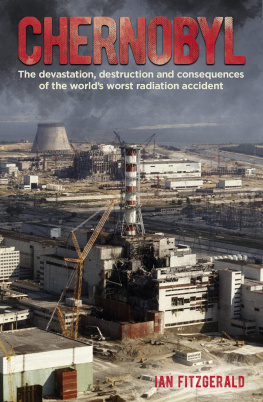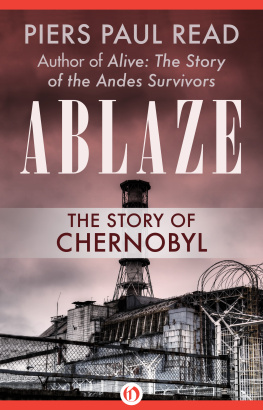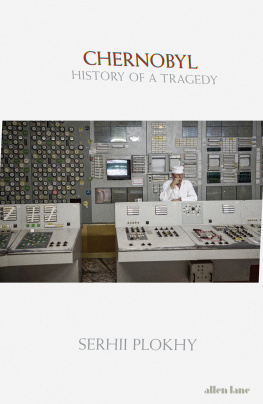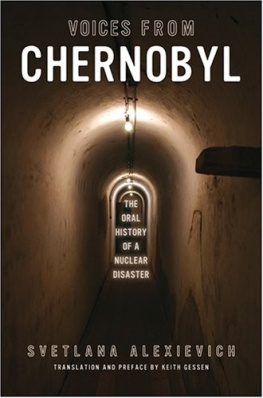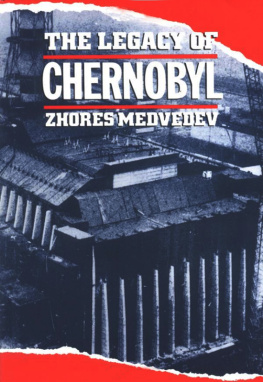Prologue:
Nuclear accidents before chernobyl
If one word sums up the concerns and complaints we have about nuclear energy, its Chernobyl.
It is the shadow that has hung over the atomic power industry since that terrible day in April 1986 when the facilitys Unit 4 reactor, powered by U-235 uranium dioxide, exploded, releasing a poisonous, radioactive cloud that infected much of Europe, and tainted whatever good name the industry had, perhaps forever.
The story behind the Chernobyl catastrophe is one of human error, design failure, technical incompatibility, and institutional mismanagement. As such, it is tempting to think of it as a freak accident, a one-in-a-billion alignment of unique and very specific factors that could never be repeated. Thats certainly the argument put forward by those involved in the nuclear energy industry, and it is plausible. But what nuclear energys defenders dont address is that Chernobyl is just one albeit the worst of a series of accidents that have happened since the atomic power industrys inception in the early 1950s. And it wasnt the last power plant failure either. Accidents take place, lessons are learned, technological and safety improvements are made and then another accident occurs. Chernobyl may be this eras byword for nuclear catastrophe, but before that, as we will see, it was Windscale and Three Mile Island. Then, in March 2011, the reactor meltdowns at Fukushima in Japan were the equal of the disaster at Chernobyl.
This does not mean, however, that the worlds atomic energy nations are actively decommissioning their existing nuclear power stations or halting the construction of new ones. A few states are, such as Germany, but more countries including France, India and China are ramping up their nuclear energy programmes. There are also at least 30 states without nuclear power station that are planning to build them, such as Indonesia, Turkey and Egypt. For those countries committed to nuclear energy, the perceived pros of atomic power are just too tempting when measured against the cons. Once a nuclear power station is up and running it can produce electricity in a cheap and very efficient way. As a fuel source, the world reserves of uranium will outlast those of coal, oil and gas, seeing us through to the end of this century. While we wean ourselves off fossil fuels, nuclear power is the ideal transitional energy source, so the argument goes, until we develop something more sustainable and environmentally friendly. All of this, policymakers around much of the world agree, is worth the small risk of something going wrong.
But go wrong it does. In the century or so that humanity has been working with radioactivity weve had our fingers burned by it on more than one occasion as the story of Clarence Dally will attest.
A glassblower by trade, Dally worked in the laboratory of Thomas Edison in the 1890s and assisted with the development of the great inventors fluoroscope machine, an early X-ray imaging device that contained radioactive elements. The German physicist Wilhelm Rntgen had discovered X-rays in 1895, and almost immediately entrepreneurs as well as scientists began to search eagerly for ways to exploit the possibilities offered by the new wonder technologys ability to see inside the human body. No one at the time fully understood the dangers of radiation, and scores of people like Dally willingly exposed themselves to it on a daily basis.
The first sign that something was wrong with Dally came in 1900, when his face and hands began to exhibit signs of cell damage. By 1902, severe lesions on his left hand meant he had to receive skin grafts. When these failed, the hand was amputated. Shortly after this, he lost four fingers on his right hand. The X-ray has affected poisonously my assistant, Thomas Edison observed.
But these interventions did not stop the carcinoma spreading across Dallys body. First, both of his arms were amputated up to the elbow, and then to the shoulder. When he died of mediastinal cancer in 1904, Clarence Dally became Americas (possibly the worlds) first-ever victim of radiation poisoning, prompting the New York Times to declare him a martyr to science. Edison regarded Dallys plight as a cautionary tale and he immediately abandoned his researches into X-rays.
But if Thomas Edison was chastened by his experiment with radioactivity, others were intrigued. In Paris, France, Henri Becquerel and the husband-and-wife team of Marie and Pierre Curie were jointly awarded the 1903 Nobel Prize in Physics for their work studying the effects of radiation. All three scientists had by this time suffered in various degree from radiation burns to the skin. Two of them Becquerel in 1908, and Marie Curie in 1934 almost certainly died from cancers associated with their work. (Pierre Curie died in a road accident in 1906.)
Elsewhere in the French capital, at the Piti-Salptrire Hospital, an assistant named Blanche Wittmann in the institutes radiology department lost her fingers over time and then parts of her arms because of prolonged exposure to radioactivity. She died in 1913, aged 54. Ten years later, Wilhelm Rntgen himself succumbed to colorectal cancer, which may well have been caused or exacerbated by his work with radioactive materials.
Scores of other scientists and medical personnel endured burns, illnesses and in some cases death from radioactive exposure in the early years of the 20th century. But they were not alone. Keen to cash in on the publics interest in the new phenomenon of radiation, many manufacturers, from the 1910s until well into the 1930s, developed a wide range of dangerously irradiated consumer products, many of which sold very well.
These included radium-infused face creams and toothpastes, and even radioactive chocolate bars. Then there were the radium suppositories and enema treatments for people with digestive troubles, as well as the Radiendocrinator, a credit card-sized case containing around half a dozen radium-soaked pieces of blotter paper. Advertised throughout the 1920s as a means to invigorate sexual virility for men, users were advised to place the Radiendocrinator inside a jockstrap or athletic support when going to bed, taking care it sat just behind the scrotum. Priced at around $12,000 in todays money, only the very rich (and the very gullible) could afford it.
The inventor of this product was William J Bailey, who was also responsible for Radithor. Created in 1918, Radithor was a water-based drink containing radium, advertised as Instant Sunshine. Its makers claimed it cured impotence and various other ailments, but it fell out of favour in spectacular fashion with the death in 1932 of the American industrialist and playboy Eben Byers, one of Radithors most high-profile champions. He drank it several times a day and is estimated to have consumed around 1,400 doses between 1927 and 1930. By the time he stopped taking it, he was already experiencing headaches and weight loss. Soon, his teeth fell out and his upper jaw and most of his lower jaw had to be surgically removed. At the time of his death, several bones and areas of tissue throughout his body had severely dissolved and holes had opened up in his skull. His demise was later reported in the Wall Street Journal under the pithy headline: The Radium Water Worked Fine Until His Jaw Came Off.
Aside from unsuspecting consumers, another affected group were the Radium Girls of the 1920s. At Connecticuts Waterbury Clock Company, they were the workers whose job it was to draw glow-in-the-dark numbers onto the dials of clocks and pocket watches with radioactive paint. Instructed to do as neat a job as possible, they habitually licked the tips of their paintbrushes to keep the bristles tidy. As a result, its estimated that between 30 and 40 workers died at this and similar factories in Illinois and New Jersey from mouth cancers and related diseases.

